


Sheaffer Snorkel Era Nib Codes 1952-1958
by Jim
Mamoulides, September 11, 2003
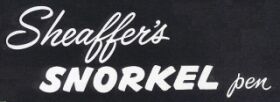
Making The Grade
Grading pen nibs can be a challenge, especially with the tendency for modern nibs to be a shade wider than their vintage counterparts. Most of us who have picked up a modern pen have noticed that they are marked on the nib or section with the grade, and usually in simple letter form, such as F, M, or B, for fine, medium, and broad, respectively. Vintage pens are often not nearly so intuitive in their markings.
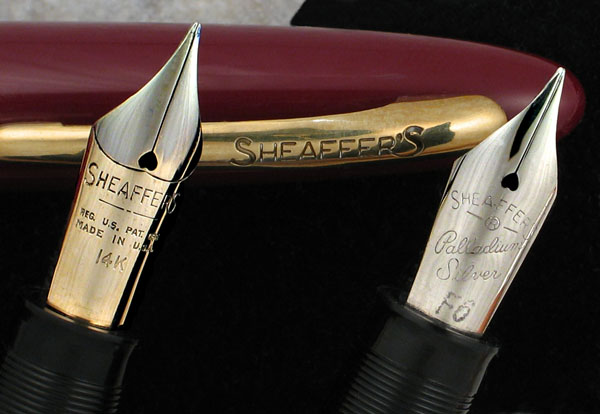
Sheaffer 14 Karat Two-Toned Palladium Masked Open Nib (Left) From Snorkel Sovereign Model
Sheaffer Palladium-Silver Open Nib (Right) From Special Model
Note F6 Marking For Fine Point / Palladium-Silver Open Nib On Right Nib
In early vintage pens one may find a number on the nib, from 0 to 12. This number system indicated the physical size of the nib rather than the grade, with 0 size being a very small nib, as may be seen on a small ringtop pen and a 6 or 8 size might appear on a large pen similar in size to a Parker Duofold. A 10 or 12 size nib would be very rare and very large (think shovel) nib, and would only appear on a very large oversize pen. Early pens would often be shipped with paper bands or stickers that indicated the nib grade. Considering the amount of handwork involved in these pens, it's easy to visualize the final testing and packing including a step to attach the grade band to the pen before placing it in the box.
Breaking The Sheaffer Code
When the Sheaffer Snorkel was introduced in 1952, Sheaffer offered the pen with sixteen catalogued point grades and five nib types. To keep things straight, Sheaffer created a code system to visually identify the nib type and grade. These codes will show on the face of open nibs or on the back of Triumph or sheath nibs.
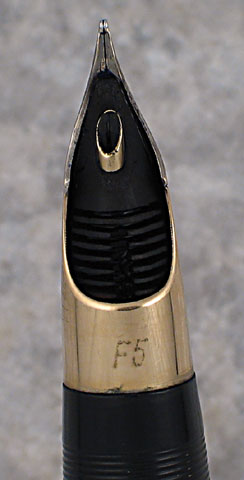
Underside Of Sheaffer Snorkel Valiant Model Nib
Note F5 Marking For Fine Point / 14 Karat Two-Toned Palladium Masked Triumph Nib
The code will be lightly etched as a two digit "core" code indicating the point grade and the nib style, with a prefix and / or suffix digit added as a modifier. In all cases, the first core digit is a letter code for the grade and the second core digit is a number code indicating the type or style of the nib. The vast majority of nibs will only have two digits.
The letter point grade codes (first digit) are as follows:
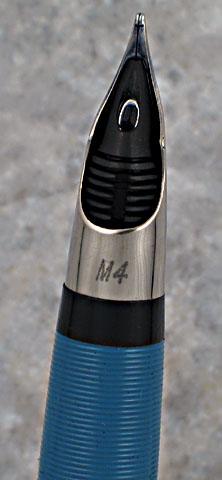
Underside Of Sheaffer Snorkel Clipper Model Nib
Note M4 Marking For Medium Point / Palladium-Silver Triumph Nib
Sheaffer also made a three tine Music nib, but I haven't seen any examples to determine if they have a letter point grade code or not, and what the code may be.
The number style codes (second digit) are as follows:
There are also additional letter codes (prefix or suffix digits to the above two, when used) that indicate either Flexible, Left Oblique, or Right Oblique, as follows:
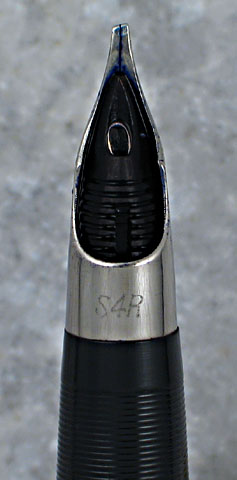
Underside Of Sheaffer Snorkel Statesman Model Nib
Note SR4 Marking For Right Oblique Stub Point / Palladium-Silver Triumph Nib
Given a large number of Snorkels, one may only find a few pens with codes marked on them. There are two reasons for this. First, the code etching is very light and can be easily polished out. Second, Sheaffer stopped marking the nibs sometime in 1958, so those pens would not have coded nibs.
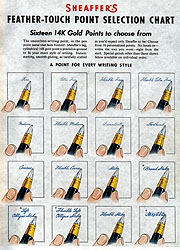
Nib Code Page From 1953 Sheaffer Catalog
So What Nib Style Goes On Which Pen?
Each Snorkel pen model used a specific nib, which in some cases was the principal difference between two models. For example, the Clipper and Sentinel are exactly the same pen, except the Clipper is fitted with a Palladium-silver Triumph nib (number 4) and the Sentinel is fitted with a 14 karat two-toned palladium masked Triumph (number 5). The Saratoga / Admiral and Statesman / Valiant models are distinguished in the same way. Here is how the models break down by style code:
What's The 5 On The Admiral Nib Mean?
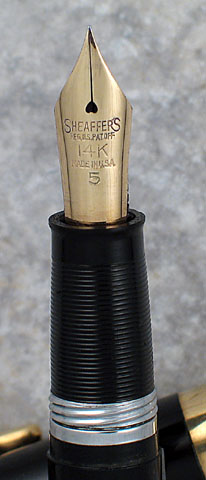
Sheaffer Snorkel Admiral Model Nib
Note 5 Marking For 14 Karat Open Nib
Many collectors will look at the above list with a Snorkel Admiral in hand and say, "Great, but what does that 5 in the center of the nib mean?" It's not a mistake. It's a hold-over from an older Sheaffer nib numbering system where 5 indicated a plain 14 karat gold open nib (no palladium mask). Evidently, Sheaffer's nib making machine or nib stamp had the 5 as part of the stamp and it was probably too much trouble to remove it.
What About Tip-Dip Pen Codes?
Interestingly, the codes also apply to the steel nibbed Tip-Dip Touchdown pens. In all cases on Tip-Dip pens, the second "core" digit will be the number 1, indicating a stainless steel open nib. Tip-Dip pens had a more limited number of point styles, a subset of the sixteen available on the Snorkels and no obliques.
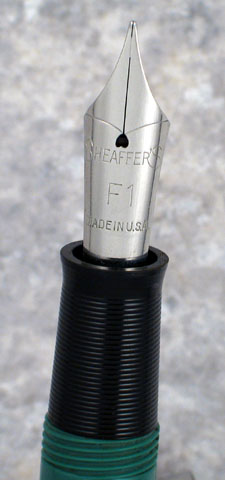
Sheaffer Tip-Dip Craftsman Model Nib
Note F1 Marking For Fine Point / Steel Open Nib
Tip-Dip nibs were initially offered in Extra Fine, Fine, Medium, Broad and Stub in three levels of firmness: firm, semi-flexible, and flexible, as well as Shorthand. This gave a total of sixteen choices, as with the Snorkels. By the 1963 Catalog, the list had grown much shorter and shows only six nibs: Shorthand, Extra Fine, Fine, Medium, Broad and Stub, with no indication of any flexibles, so all were likely firm nibs.
Breaking The Code
The 1953 Sheaffer Catalog lists the following sixteen gold Triumph points. Each is listed below with their corresponding codes from the table above.
Having no marked example of a Flexible Left Oblique Stub, it's a good guess that the coding would be FS5L, but I'll wait until I see one. The same goes for the Broad Stub, which might be a BS5 or an SB5, using "core" codes as a prefix. If there is a medium or fine Stub, though not listed, it would seem logical that it would follow the same pattern. As stated above, since I don't have a marked Music nib, I don't know what, if any code was used.
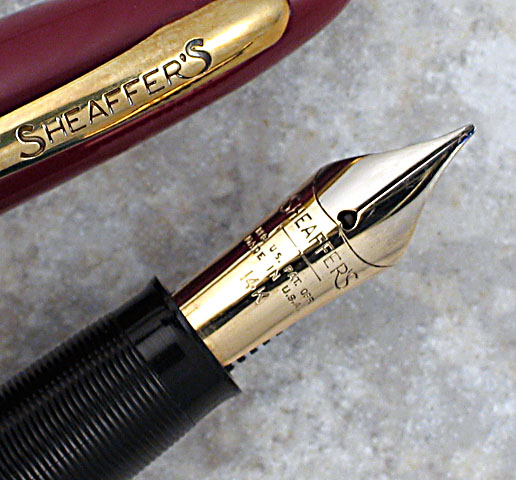
Sheaffer 14 Karat Two-Toned Palladium Masked Open Nib From Snorkel Saratoga Model
Clearly, this list is not the complete list of all identified Snorkel nibs. There is also a Right Oblique Stub nib and a Flexible Right Oblique Stub, for example. The list could be eighteen, or more, given some additional possible combinations.
Hopefully this has both cleared up and added a dimension of mystery to the code story. At least the code is decipherable! Consider yourself an official Sheaffer Snorkel "code breaker"!
So much of the information in this article is from the works of Sam Marshall that I feel it necessary to give him credit for his extensive research.
Acknowledgement
Thanks to Sam Marshall for his extensive research and help.
Comments on this article may be sent
to the author, Jim Mamoulides
PenHero.com Bibliography